Neptune Beach, Florida Before 1931
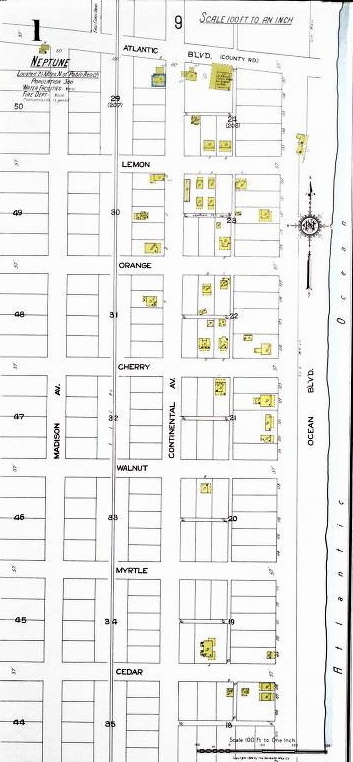
© 2006 Donald J. Mabry
Contemporary Neptune Beach, Florida, part of greater Jacksonville (See Map),
Florida, was once an unnamed barren wilderness
composed of large sand dunes (some as high as thirty feet), palmetto thickets,
cabbage palms, swamps, an ocean, and a river. A few miles to the west were marsh
and San Pablo Creek. It was not named nor would be until a New Yorker fell in love with Florida at
age 48, and made a second career as a real estate, hotel, and railroad
developer. Yankees and other foreigners began altering this pristine area,
sometimes to the good, sometimes to the bad.
Henry Flagler, the New Yorker, ran his little railroad through Neptune on
its way to his oceanfront Continental Hotel in Atlantic Beach and then north
to Mayport on the St. Johns River, where it picked up coal and freight. This
Florida East Coast Railway was originally the narrow gauge Jacksonville and
Atlantic Railroad which ran from South Jacksonville to Pablo Beach. Flagler
bought it, converted it to standard gauge, and extended the line to Mayport.
Flagler"s FEC train arrived at the Beaches in 1900. On
June 1, 1901, Flagler opened his Continental Hotel in Atlantic Beach. This
massive yellow hotel was 47 feet by 447 feet with a six-story rotunda and five-story
wings. The dining room could seat 350. There were 186 sleeping apartments
(later 200) and 56 baths. The hotel reservation contained other buildings such
as servants" quarters (white and black), a bowling alley, a power plant, water
works, and a depot. The grounds were beautifully landscaped; patrons could walk
onto the long ocean pier to sightsee or fish. But it still existed in the wilds
until Flagler"s real estate development arm began populated the Atlantic Beach
coast with cottages/bungalows, mostly summer homes for the well-to-do. Flagler
was immensely wealthy, being one of the Standard Oil Company founders, and this was his
grandiose dream at the time.
S. J. Meyers, a New York City jeweler, bought land south of the Hotel from Flagler
in 1902, so he could develop Atlantic Beach South. Flagler had bought the land
for taxes; ownership had been in litigation for years. Flagler soon decided to jettison the
property. Meyers thought he could turn the
"big sand bluff" called Neptune into a settlement of streets, squares, a park,
and a hotel. His idea was that Neptune would be less grand than Atlantic Beach
but a step above Pablo Beach to the south.[1]
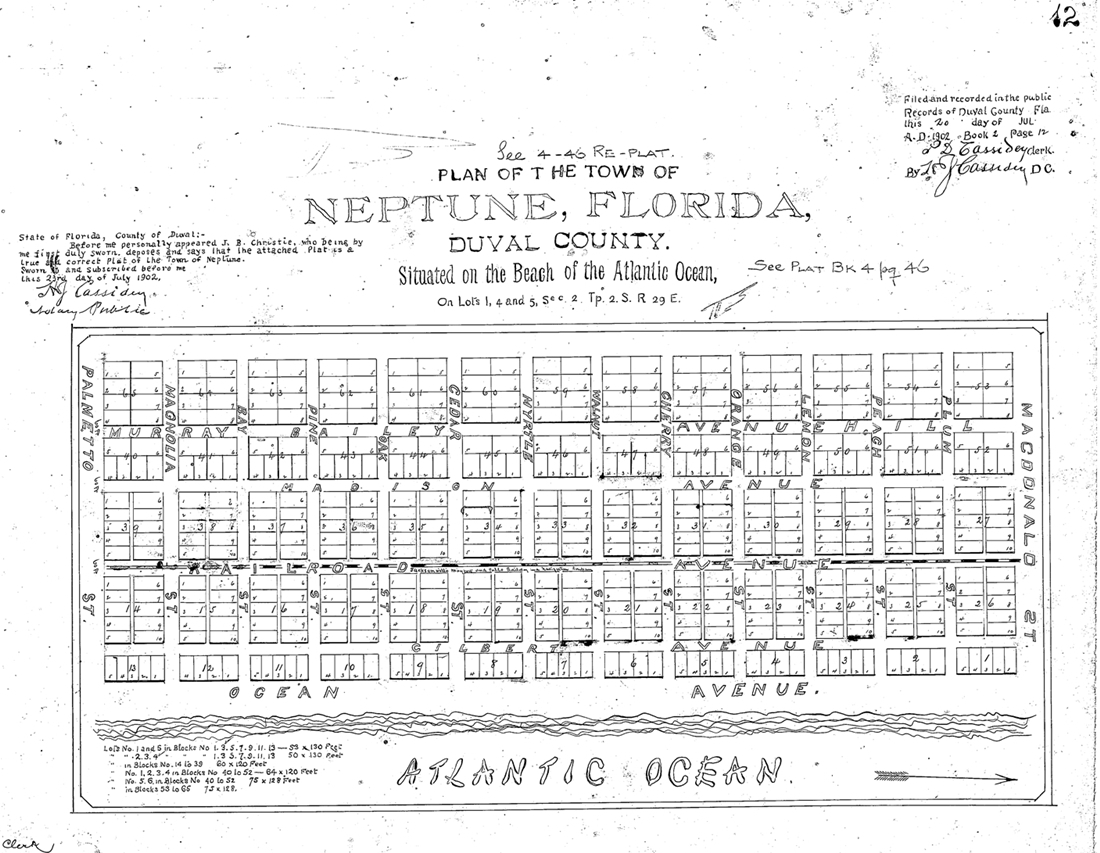
Nothing
came of it because Flagler, who owned the little railroad that was the only
convenient means to reach Neptune, had no incentive to help competition. Thomas
V. Cashen had built a house half a mile south in the late 19th
century. Cashen had earned his wealth in the lumber business and wanted a
summer cottage but away from Pablo Beach, which was settled in the 1880s. He
had the FEC put a little railroad stop near his house, as this 1918 map shows.
It also shows the railroad tracks, the sparse settlement of the region, the Continental/Atlantic
Beach Hotel, and Neptune (shown where Atlantic Boulevard is). The Neptune Station
was on Beach Avenue in what now is Atlantic Beach.
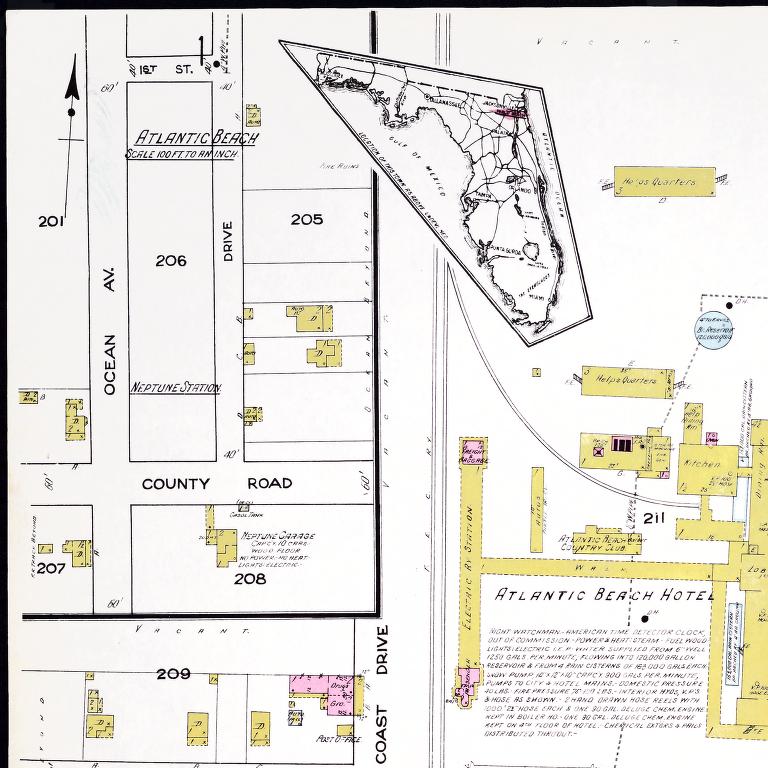
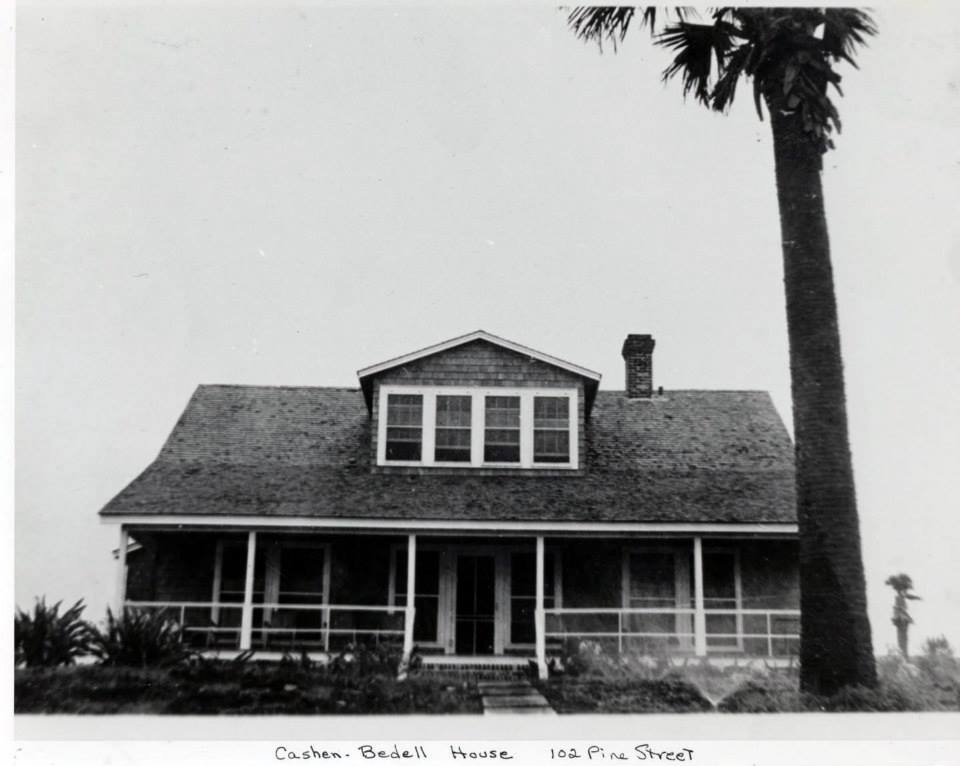
Cashen-Bedell House 102 Pine Street,
Neptune Beach
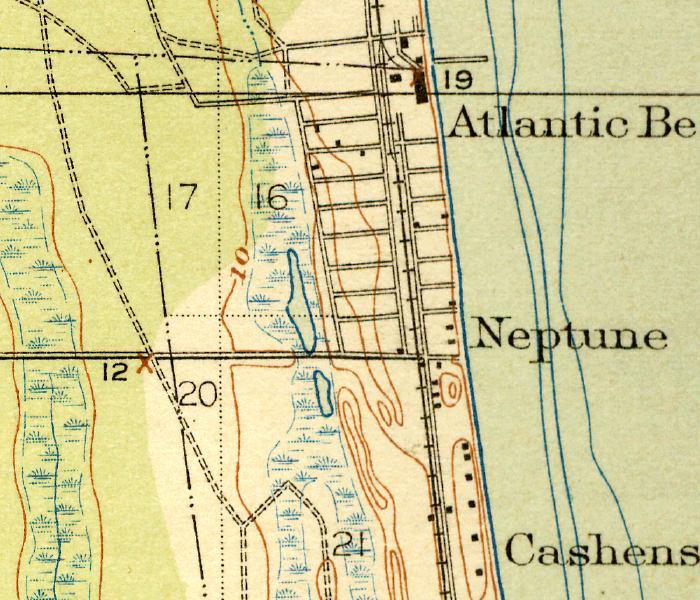
1918
For
either Atlantic Beach or Neptune to develop more people had to be able to get
there. The railroad fare favored the more prosperous; what was needed was a
road. E. F. Gilbert,a U.S. Army veteran from Connecticut had moved to
Jacksonville. He was a jeweler and a land speculator. He bought six parcels of
land at Neptune, land which had little value unless people could get there. He
lobbied the county commission to use convict labor to hack out a wagon road
from South Jacksonville to the beaches but work was stopped. His son, Fred
Gilbert, eventually got it completed; Atlantic Boulevard opened in 1910[2]
In Neptune, the northernmost section of Pablo Beach was replatted in 1911. It
extended into present-day Atlantic Beach,[3]
but the completion of the Boulevard forever divided Neptune. When the Town of
Atlantic Beach was created in 1925, Atlantic Boulevard became the southern
boundary.[4]
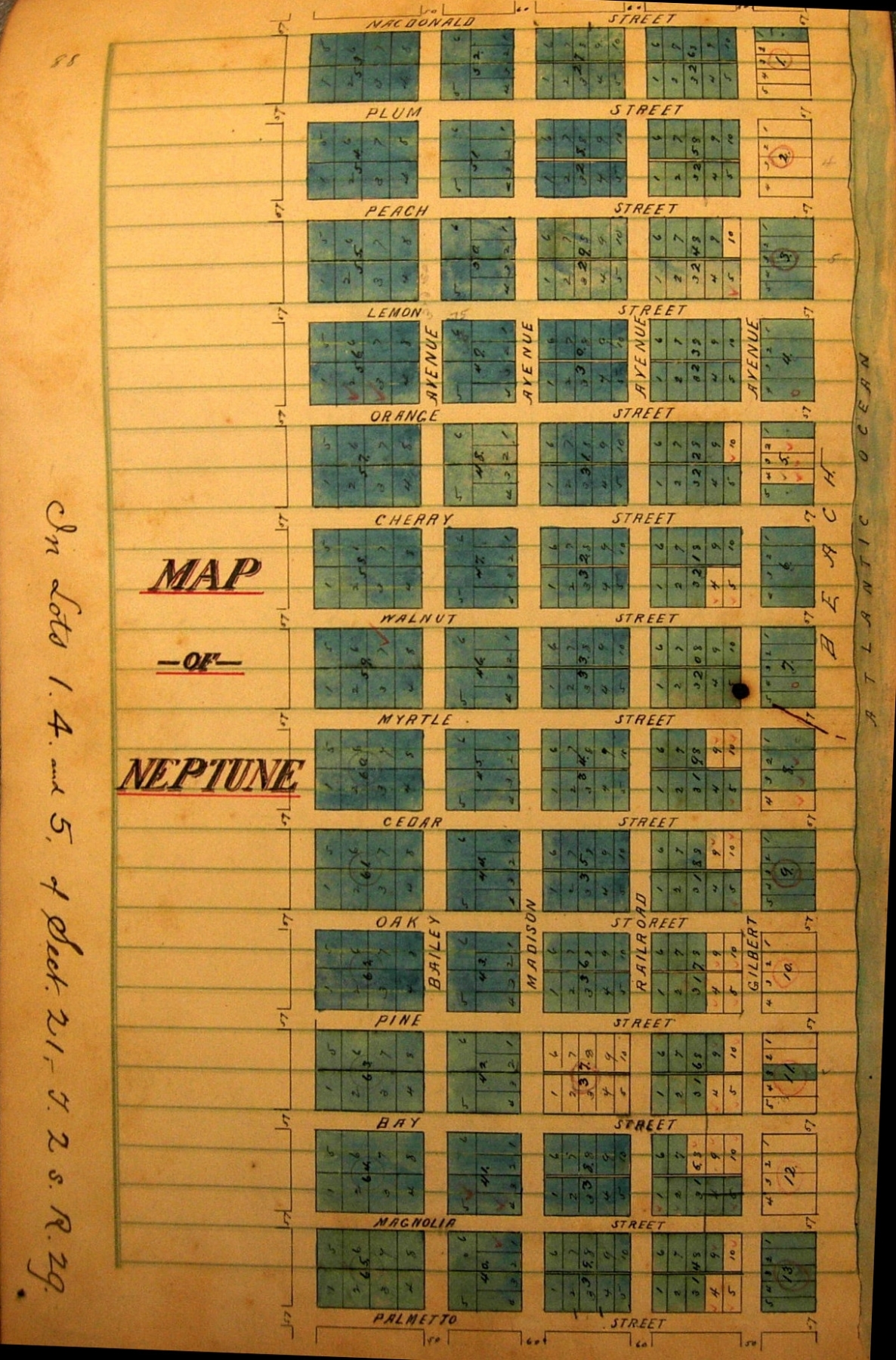
Men
of vision did not give up. In 1913, the Atlantic Seashore Company, organized by
Captain Charles E. Garners of the
Florida National Bank, Thomas Clarke, and George E. Carroll decided to
develop Neptune as a new beach property just south of Atlantic Beach.[5]
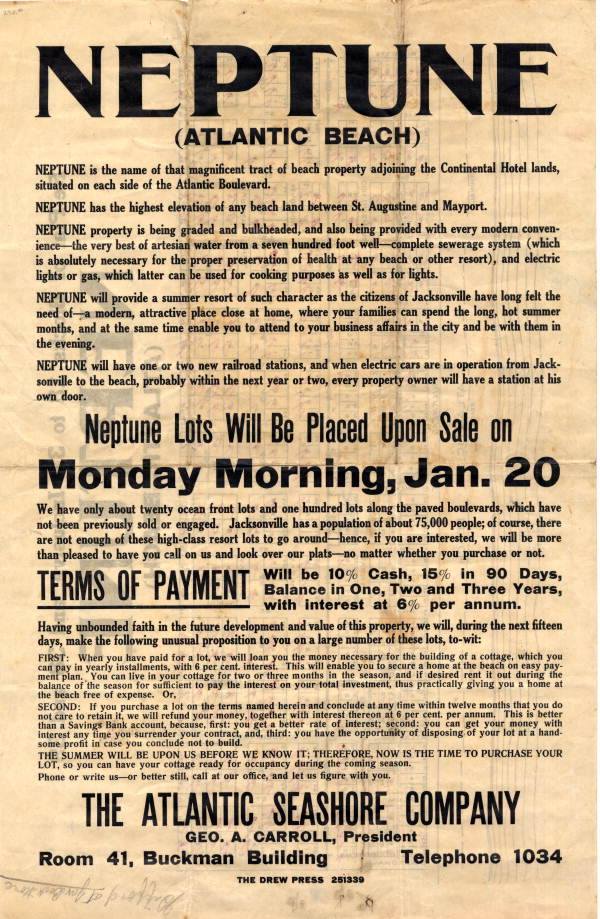
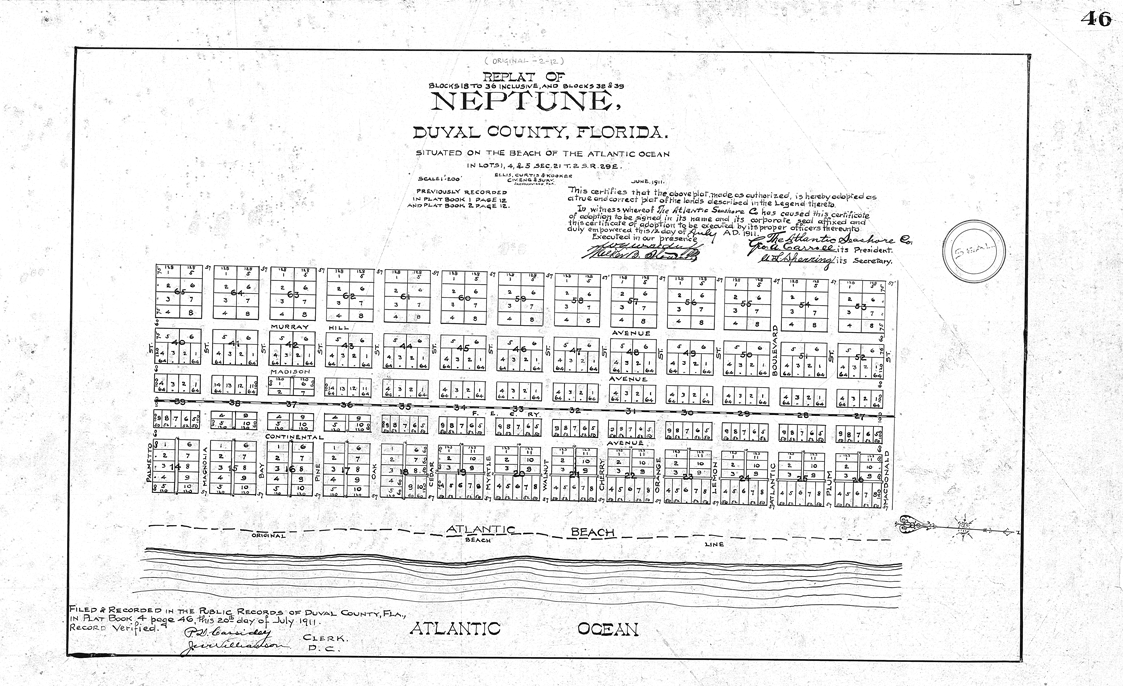
The area got publicity when Lieutenant James
Doolittle, later famous for bombing Tokyo in World War II, left the Neptune
Beach portion of Pablo Beach on a transcontinental flight to San Diego in 1921,
arriving in 21 hours and 18 minutes.[6]
The takeoff point was chosen because there was very little population and the
beach was very wide. Perhaps it helped.
It
is not clear when the area became known as Neptune. George Simons, in a report
to the Beaches Area Chamber of Commerce, said: A Plat titled, "Plan of Town
of Neptune Beach" was recorded as early as July 2, 1902, five years before
the incorporation at the Town of Pablo Beach. This original plat however was
revised in 1911. In 1922, Dan G. Wheeler, Sr. had a cottage on the ocean front
near the current Sea Turtle Inn. He was manager of Richardson & Conroy in
Jacksonville and he and his family spent summers at the beach. To get to work
in Jacksonville, he had to walk almost to Mayport to catch the train. Told that
the train would only stop at a station, he built one and called it Neptune.[7]
That is the conventional wisdom. However, an undated Atlantic Beach Corporation
map refers to Neptune and includes land south of Atlantic Boulevard. This map
may have been drawn as early as 1917 when the Corporation went into bankruptcy
and was reorganized.
Regardless,
what became Neptune Beach was only the sparsely populated area a few blocks south of the Atlantic Beach Hotel. It huddled on the south side
of Atlantic Boulevard. This piece of a 1924 Sanford Fire Insurance Company
map shows the beach as Ocean Boulevard with the Mysterious House well beyond
the current line between the beach and the settled area. Apparently, the sea
reclaimed a road. First Street was
called Continental Avenue; the FEC railroad right-of-way, is to the left (to
the west) of Continental). Many of the houses still exist, for example, the two
small houses on Cedar Street and the ocean.


The
big gap between Neptune and the main Jacksonville Beach settlement a few miles
distant was closed some by the mid-1920s when the Jacksonville Beach Real
Estate Company began building homes west of Third Street North near the present
Neptune Beach-Jacksonville Beach border. Pablo Beach had changed its name to Jacksonville
Beach in early 1925 and absorbed what would become Neptune Beach. Neptune
residents residing near Atlantic Boulevard were not terribly enthusiastic about
this but, at least, there were plenty of buffers between them and the settled
parts of Jacksonville Beach.[8]
That
changed some with the grandiose development plan of Gabe Lippman in 1925.
Lippman purchased half a mile of ocean front between Jacksonville Beach and
Atlantic Beach, that is, in what would become Neptune Beach. His land also
extended westward towards Pablo Creek. In total, he owned 2,500 acres,
including four frontage acres on the Intracoastal Waterway. Lippman planned to build a town of 25,000
people named Florida Beach, a town or city which would have a golf course,
hotel, pier, and yacht basin. He planned to build Florida Boulevard which went
from the ocean west and then northwest finally intersecting with Atlantic
Boulevard at Mayport Road. Constructing the road would necessitate a lot of
fill dirt so Lippman constructed a miniature railroad to haul it. Although he
organized a celebration on July 2, 1925 at the ocean front, little had actually
been done. He cut his losses. In October, he sold the development to Majestic
Homes Corporation of St. Louis. When Majestic Homes defaulted in June, 1926,
only a few homes had been built.[9]
Times got hard when the Florida land boom collapsed in the mid-1920s and remained that way
until the New Deal began pumping money into the beaches after 1933. Tax revenue
dropped and the Jacksonville Beach city government had to make tough choices.
Most of those living in the northern section of the city, that is, Neptune,
decided that they were paying taxes but not getting commensurate benefits. When
their complaints went unheeded, they decided to create their own town. By a
margin of 113-31, they voted to leave, creating Neptune Beach on August 11,
1931.[10]
The leaders all lived near Atlantic Boulevard. The
Polk City Directory for 1945 shows Thurston Roberts at 616 Ocean Front; T. W.
Jenks at 115 Orange; W. W. Delcher, who owned a storage company, at 120 Cherry
at 1st Street; and Joseph M. Glickstein, Sr. [11]
at1005 Ocean Front. Glickstein drew up
the town charter and became the first town attorney. The first councilmen were Thomas B. Adams,
Chalmers D. Horne, William M. Hall, T.W. Jenks, and T. T. Phillips. Horne had
been prominent in Atlantic Beach politics and developed the Mandalay
subdivision. George Bloom, another founder, was a grocer. Jensen was the first
town marshal and tax collector, and, later, the acting clerk. O. O. McCollum, the
first mayor until July, 1941, held the organizational meeting at his home on
August 15, 1931.[12]
Neptune founders availed themselves of the largesse
emanating from the liberal government of the New Deal. In May, 1933, the town
council authorized Marshall J. L Burke to build a town hall at the edge of
Lemon at Northwest corner of 1st Street for $200 or less. Works
Progress Administration workers laid foundation for the building. Burke, the
city engineer, lived in it. Late that same year, the Civil Works Administration sent 150 men to do
street maintenance, erecting bulkheads on the ocean front, water works, and
sewers.
The
little town grew in the second half of the 1930s, going from 350 persons to
1,363 in 1940.[13]
When the FEC abandoned its railroad at the seashore, the right of way became
Second Street and home sites. In the first nine months of 1936, 46 new
dwellings were built; in the first weeks of 1937, another six houses. Jensen
built his building (see image) in 1938.[14] He paid $600 for the property in 1914. It
contained the Beach Plumbing and Electric Company, a fish market, a five and
dime store, and "a package house and grill." The last became famous as Pete"s
Bar, the oldest bar in the county. By November,1939, the town had 340 dwellings,
a tiny city hall, a little business district on the south side of Atlantic
Boulevard, paved roads, a bulkhead, fire and police stations, and a water and
sewer system. In 1936-1937, fifty-two houses were built in the little town.
Neptune renamed many of its streets in 1937 to conform to the numerical system
adopted by Jacksonville Beach that same year.[15]
Streets in northern Neptune Beach had long been named but those south of
Florida Boulevard were platted by Georgaye
Floyd, who named three streets for his daughters"Myra, Margaret, and Lora.[16]
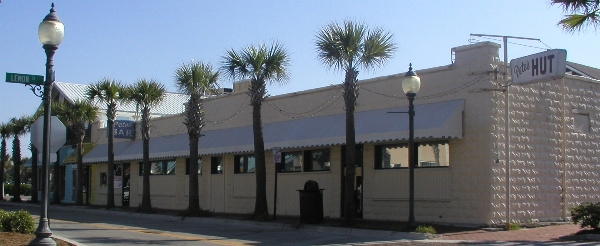
Jensen Building in 2001
More and more homes were built in
the 1930s. The prevailing lot dimensions in Neptune Beach are fifty feet by one
hundred and five feet, but a number are sixty feet by one hundred and twenty
feet. Arthur Penman built a house on Florida Boulevard in his Neptune Forest
subdivision in 1936, expanding the development of Neptune Beach.[17]
The Clements family owned the house below from 1934 until 1987 when the widow
Clements sold it. As their son, Roland W. Clements remarked "As you can see
there were no paved streets in Neptune Beach in those days. They paved Midway
and Cherry Street sometime in the early 1950's. The house to the left is the
Cobb house and they still own it."
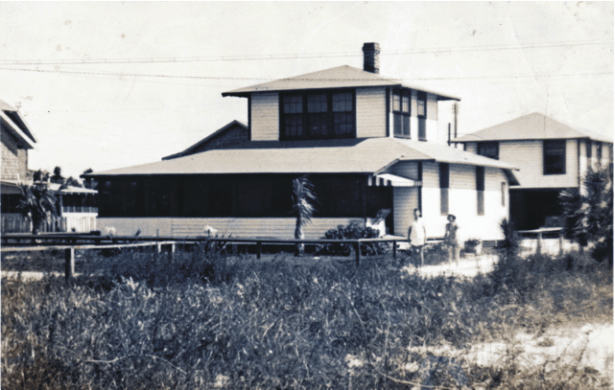
1934. Photo courtesy of Roland W. Clements.
Another glimpse of the Cherry Street area comes
from a 1951 photo supplied by Roland W. Clements. Looking toward the ocean on
Cherry Street, the house on the left is the old Howell House, owned by the
mother of Billy Howell who became mayor of Atlantic Beach for 1956-61. Clements says "both
houses were summer homes well into the late 1950s."
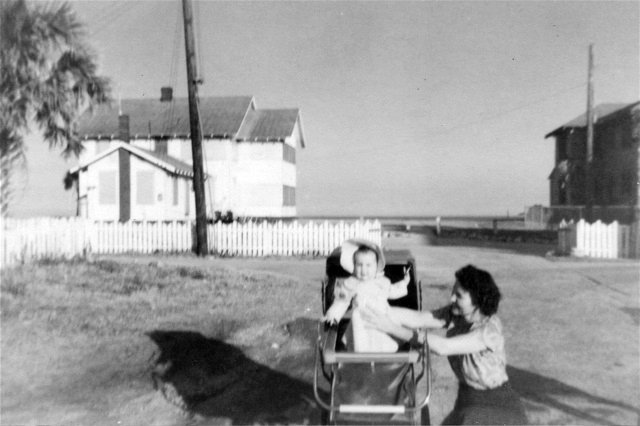
1951. Photo courtesy of Roland W. Clements
The little town, or village by some
reckonings, grew during World War II. Whereas the 1940 US census showed it
contained 1,363 persons, that number dropped to 1298 in the 1945 census, no
doubt the result of men entering the military. In 1950, however, the town had
grown to 1767 persons. It was a pleasant little village stretching a mile north-side
along the ocean and only a few blocks east to west except of limited area.
There was almost no commercial development except along Atlantic Boulevard.
Besides the Jensen building, there was the Sea Horse
Motel on the ocean. In 1956, between the ocean and 1st Street on Atlantic
Blvd, were the Surf Lodge and Walt's Neptune Tavern. On the southwest corner of
1st Street and Atlantic Boulevard was Silver's/Langston's Pharmacy. The Dallas
Shop was popular. Glover Weiss operated a radio and television business at
#207. Smith's Gulf station was at #327 Atlantic Blvd in 1956. There
was a Pure Oil station in the next block. Carleton
Motel & Cottages were at #502. Roy Young's Bar & Grill at #602.
Mary Ayoub made dresses at #624. At the corner of Atlantic Boulevard and
Mayport Rd. was Uncle John's beer business. Proceeding south on 1st Street, one
encountered Howard's Garage in the 200 block. Ed Smith Lumber
Company was prominent on First Street. The photo below, taken about 1950, shows
much of "downtown" Neptune Beach.
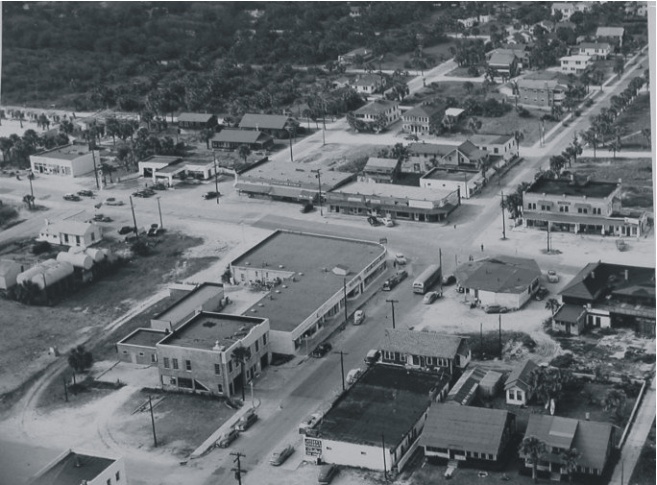
How sparsely populated Neptune Beach
was at mid-20th century is shown in the following photo looking
south from Atlantic Boulevard. The road running in the middle of the photo is 3rd
Street. Note that there is almost no development to the west, to the right of 3rd
Street. The location of today"s Jarboe Park can be seen at the top of the
photo. This 1949 section of a US Geological Survey map tells the story. The
black squares are buildings, mostly houses.

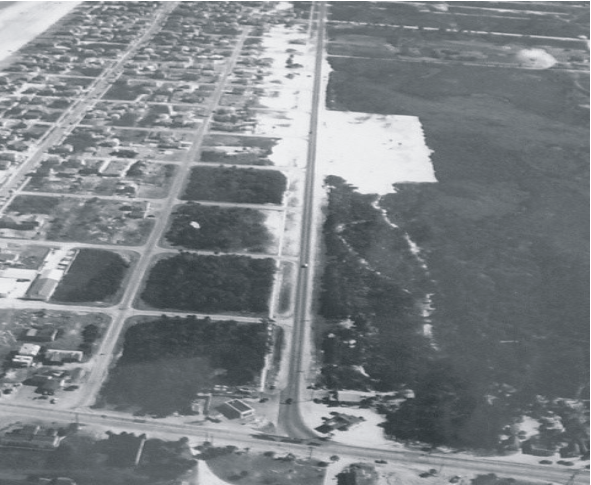
In
1947, a consolidation vote was held and had a 1,252-699 result in favor of
becoming one, but each beach had to agree. In Jacksonville Beach, it was 745-90
in favor but the Neptune Beach vote was 322 against, 309 for; in Atlantic Beach
the vote was 287 votes against and 198 votes for. Ethnocentricity was alive and
well. Neptune Beach had "escaped" from Jacksonville Beach only
sixteen years before. Atlantic Beach saw itself as
"different" from its southern brothers.[18]
The
Town of Neptune Beach enjoyed stable political leadership. For almost its first
ten years, O.O. McCollum served as
mayor (August 15, 1931-May 16, 1941). Thomas W. Jenks filled the unexpired
term, then was elected in 1943 but died in 1946. Joseph M Glickstein, Sr., a
founder of the Town finished the term and was succeeded by H. E. Lighty who
served from August 12, 1947 until 1963, presiding over the conversion of the
Town into the City of Neptune Beach.
Continuity was provide by James R. Jarboe. He
moved to Neptune Beach in 1993 and rained until his death in 1974. His wife, Olivia, was town clerk. The family
lived at 115 1st Street, that is, in a three-bedroom apartment between the city jail
and City Hall. The Fire Department was there as well. The Jarboes encouraged
wholesome activities among young people by using a large room above the Town
Hall building to show free movies on Friday nights and making it available to
such organizations as Hi-Y.
He patrolled the little town constantly and
intervened, as quietly as possible, to head off trouble, possible in a village
of so few people.
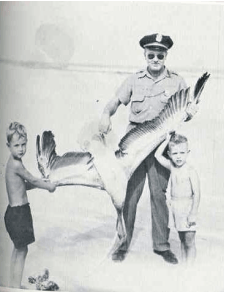
Jim Jarboe
As
Jacksonville grew in population, complexity, and geographical size, Neptune
Beach grew as well and lost some of its uniqueness.
[1] New York Commercial, June 23, 1902, as
cited in Bill Foley, "Neptune was born as a buffer For Atlantic," Florida
Times-Union, June 21, 1997.
[2] Bill Foley, "A "Typical Yankee"s
to Thank for Road: Times-Union, August 20, 1997.
[4] Bill Foley, "A "Typical Yankee"s
to Thank for Road: Times-Union, August 20, 1997. 2 Johnston, p. 53.
[5] Florida Times-Union. January 19,
1963, "Fifty Ago Today Years."
[6] Johnny
Woodhouse, ""Doolittle Took Up Challenge After Coney Died," Times to Remember:
A Calendar for 2005. The Beaches Leader, 2004; Davis, 279, 282.
[7] Simons,
George W., Jr., Report for Jacksonville Beaches Chamber of Commerce,
1944; Letter from his son, Dan G. Wheeler, Jr., July 17, 1972.
[8] Bill Foley, "Millennium
Moment: February 9, 1925, Florida Times-Union republished on February 9, 1999.
[9] Phillip
Warren Miller, Greater Jacksonville's Response to the Land Boom of the 1920s,
MA thesis, University of North Florida, 1989, pp. 91-92, 119ff. He cites the Florida
Times-Union and the Jacksonville Journal.
[10] "Neptune Beach has maintained residential image for 50 years." Sun-Times, Wednesday, August 5, 1981.
[11] His son. Joseph, Jr. was city
attorney for 26 years, 1961-1987. Florida Times-Union, August 18, 1991.
[12] Smith, Ed Interview with, 1977.
typescript
[13] Florida
State Census, 1935; the US Census for 1940.
[14] 03 Report, pp. 75-76.
[16]
February 1, 1996 letter of John P King, 111 Florida Boulevard, Neptune Beach.
Jean McCormick Archives, Beaches Area Historical Society.
[17] Johnston, pp. 73-75.
[18] Simons, pp. 21-47; Bill Foley, "Millennium Moment: July 8, 1947,
Two strikes knocked out Beaches consolidation," Florida Times-Union,
July 8, 1999.
_________________________
101006
061915

